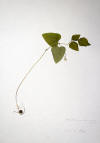WILD
FOODIES' HOME PAGE
PLANT PROFILE LIST
NAME: American Hog Peanut
SPECIES / FAMILY: Amphicarpaea Bracteata / Fabaceae or Leguminosae
OTHER COMMON
NAME(S): Wild Peanut, Ground bean
CONDITIONS: shade
/ moist soil
|
PARTS: |
EDIBLE |
TASTE |
RAW/COOK |
SEASON |
|
All |
|
|
|
|
|
Shoots |
|
|
|
|
|
Leaves |
||||
|
Stalk/Stem |
|
|
|
|
|
Buds |
||||
|
Flowers |
|
|
|
|
|
Fruits |
|
|
|
|
|
Pods |
|
sweet |
COOK |
Fall |
|
Seeds |
|
sweet/peas |
COOK |
Fall |
|
Nuts |
|
|
|
|
|
Roots |
|
|
PEEL/BOIL |
Fall |
|
Bark |
|
|
|
|
PORTION: small-medium
COMMENT: Two types of seed are produced - flowers produced near the ground produce a pod that buries itself just below soil level. These pods contain a single seed are up to 15mm in diameter which can be used as a peanut substitute. They can be harvested throughout the winter and can be eaten raw or cooked. They are sweet and delicious raw with a taste that is more like shelled garden beans than peanuts. Yields are rather low, and it can be a fiddle finding the seeds, but they do make a very pleasant and nutritious snack. Other flowers higher up the plant produce seed pods that do not bury themselves. The seeds in these pods are much smaller and are usually cooked before being eaten. They can be used in all the same ways as lentils and are a good source of protein. The overall crop of these seeds is rather low and they are also fiddly to harvest. Root - Fleshy and nutritious according to one report, whilst another says that the root is too small to be of much importance in the diet. Our plants have only produced small and stringy roots.
CAUTION: Always go slow with any plant in case you are allergic or sensitive to it. //
NUTRITION/MEDICINAL: An infusion of the root has been used in the treatment of diarrhea. Externally, the root has been applied to bites from rattlesnakes. A poultice of the pulverized leaves has been applied with any salve to swellings.(1)
LOOK-A-LIKES:
POISONOUS LOOK-A-LIKES:
OTHER USES:
SOURCE LINKS (may include nutritional and medicinal info, plus other uses):
- https://pfaf.org/User/plant.aspx?latinname=Amphicarpaea+bracteata
- https://en.wikipedia.org/wiki/Amphicarpaea_bracteata
- http://tcpermaculture.com/site/2013/05/07/permaculture-plants-hog-peanut
- https://commons.wikimedia.org/w/index.php?search=Amphicarpaea+Bracteata&title=Special%3ASearch&go=Go (photos)
- https://wimastergardener.org/article/american-hog-peanut-amphicarpaea-bracteata







